Mountain Cycling Ultramarathon Impacts in Inflammatory and Hemoglobin Responses.
Keywords
Abstract
This study aimed to analyze the cumulative physiological burden of repetitive, strenuous exercise held during mountain cycling ultramarathon on regulatory mechanisms of hemoglobin degradation.
Fifty-five nonprofessional athletes (mean age, 44.8 ± 7.1 yr) participating in a 9-consecutive-day mountain cycling ultramarathon (TransPortugal) underwent anthropometric, hematological, and biochemical assessments before and immediately after the race. Participants were further stratified as completers (nine courses) or noncompleters and were divided according to the time they took to complete the race. The heme oxygenase-1 (HMOX1) functional genetic polymorphism and haptoglobin (HP) phenotypic variants were also analyzed.
Total leukocytes, neutrophil count, and monocyte count increased, whereas decreases in erythrocyte counts and hemoglobin were found between pre- and postultramarathon. Circulating haptoglobin (Hp) was increased, whereas its soluble receptor (sCD163) decreased. Athletes who completed all nine courses presented with increased leukocyte, neutrophil, and erythrocyte counts, as well as hemoglobin, red cell distribution width, total bilirubin, and total cholesterol levels. High-sensitivity C-reactive protein and Hp decreased in comparison with noncompleters. HMOX1 and HP genetic polymorphisms were associated with biochemical profile, notably with Hp levels. Analysis of covariance showed a significant effect of HP phenotype in Hp circulating levels at the end of race and on the magnitude of variation from pre- to postrace.
Present findings support a comodulatory influence of genetic- and exercise-associated factors on resulting inflammatory and hemoglobin catabolic marker Hp after highly demanding endurance exercise.


